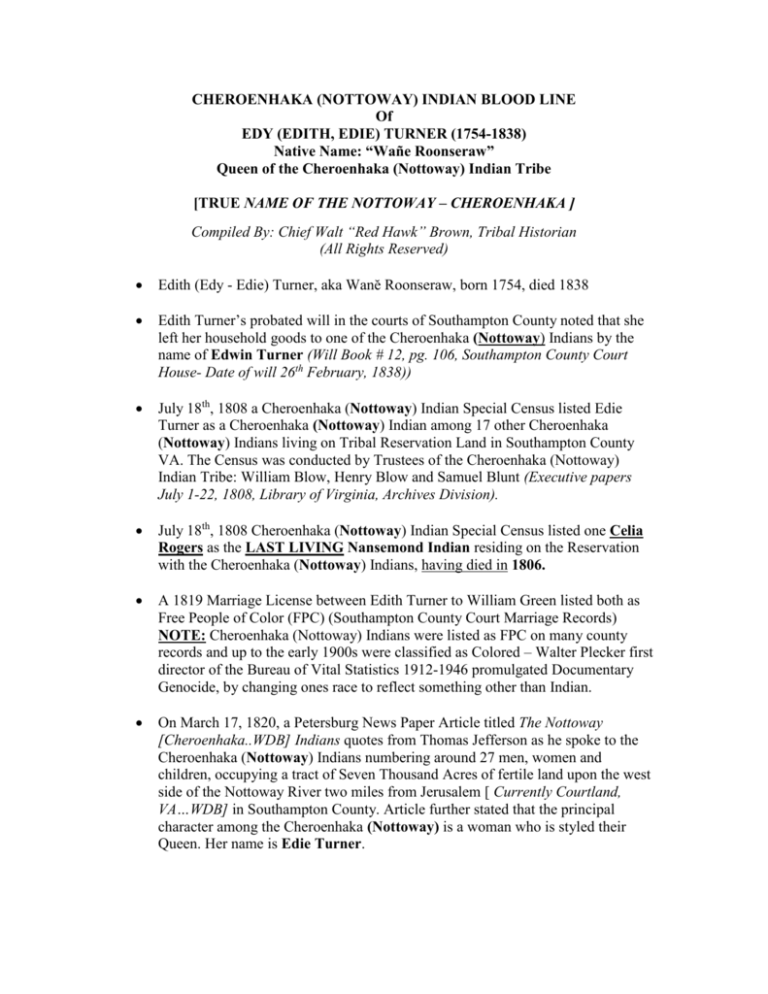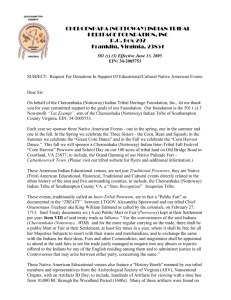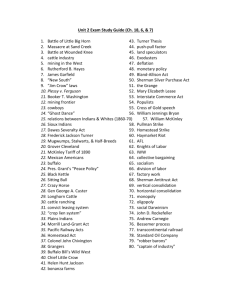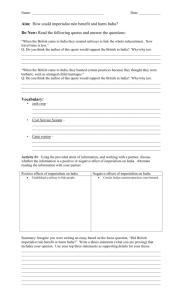
CHEROENHAKA (NOTTOWAY) INDIAN BLOOD LINE
Of
EDY (EDITH, EDIE) TURNER (1754-1838)
Native Name: “Wañe Roonseraw”
Queen of the Cheroenhaka (Nottoway) Indian Tribe
[TRUE NAME OF THE NOTTOWAY – CHEROENHAKA ]
Compiled By: Chief Walt “Red Hawk” Brown, Tribal Historian
(All Rights Reserved)
Edith (Edy - Edie) Turner, aka Wanĕ Roonseraw, born 1754, died 1838
Edith Turner’s probated will in the courts of Southampton County noted that she
left her household goods to one of the Cheroenhaka (Nottoway) Indians by the
name of Edwin Turner (Will Book # 12, pg. 106, Southampton County Court
House- Date of will 26th February, 1838))
July 18th, 1808 a Cheroenhaka (Nottoway) Indian Special Census listed Edie
Turner as a Cheroenhaka (Nottoway) Indian among 17 other Cheroenhaka
(Nottoway) Indians living on Tribal Reservation Land in Southampton County
VA. The Census was conducted by Trustees of the Cheroenhaka (Nottoway)
Indian Tribe: William Blow, Henry Blow and Samuel Blunt (Executive papers
July 1-22, 1808, Library of Virginia, Archives Division).
July 18th, 1808 Cheroenhaka (Nottoway) Indian Special Census listed one Celia
Rogers as the LAST LIVING Nansemond Indian residing on the Reservation
with the Cheroenhaka (Nottoway) Indians, having died in 1806.
A 1819 Marriage License between Edith Turner to William Green listed both as
Free People of Color (FPC) (Southampton County Court Marriage Records)
NOTE: Cheroenhaka (Nottoway) Indians were listed as FPC on many county
records and up to the early 1900s were classified as Colored – Walter Plecker first
director of the Bureau of Vital Statistics 1912-1946 promulgated Documentary
Genocide, by changing ones race to reflect something other than Indian.
On March 17, 1820, a Petersburg News Paper Article titled The Nottoway
[Cheroenhaka..WDB] Indians quotes from Thomas Jefferson as he spoke to the
Cheroenhaka (Nottoway) Indians numbering around 27 men, women and
children, occupying a tract of Seven Thousand Acres of fertile land upon the west
side of the Nottoway River two miles from Jerusalem [ Currently Courtland,
VA…WDB] in Southampton County. Article further stated that the principal
character among the Cheroenhaka (Nottoway) is a woman who is styled their
Queen. Her name is Edie Turner.
On July 7, 1820, Thomas Jefferson opened up lines of communication by sending
a letter along with the recorded vocabulary of the Cheroenhaka (Nottoway)
Indians to Peter S. Duponceau, a student of Indian Languages, residing in
Philadelphia. Jefferson references the vocabulary of the Cheroenhaka
(Nottoway) Tribe of Indians that he had obtained from John Wood, a former
Professor of Mathematic at the College of William & Mary.
Thomas Jefferson communicates to Peter S. Duponceau that the vocabulary of the
Cheroenhaka (Nottoway) Indian was obtained from an old Indian Woman, who
according to Jefferson her intellect was higher than the lower order
[slaves…WDB], by the name of Edie Turner on the 4th of March, 1820 by John
Wood. (Manuscripts Obtained from the American Philosophical Society,
Philadelphia, PA)
Thomas Jefferson infers in his letter to Peter S. Duponceau that probably the
Cheroenhaka (Nottoway) Indian Vocabulary is Powhatan [Algonkian
Speakers…WDB].
o This assumption by Thomas Jefferson was proven to be incorrect as
documented in response letters from Peter S. Duponceau to Mr. Jefferson
on the 12th of July, 1820.
Letter from Peter S. Duponceau to Thomas Jefferson dated the 12th of July 1820
conveys to Mr. Jefferson that the vocabulary of the Cheroenhaka (Nottoway)
Indian as recorded by John Wood from Edie Turner is Iroquoian and not of the
Powhatans or Lenape, [Algonkian Speakers…WDB], but an Iroquois
physiognomy. He further states in his letter to Mr. Jefferson that the Cheroenhaka
(Nottoway) Language is essentially Iroquois and is compounded of the different
dialects of the Six Iroquoian Nations – the two principal dialects of the Iroquois
Nation the Onondaga and the Mohawk.
Peter S. Duponceau’s letter to Mr. Jefferson, on July 18, 1820 quoting Rev. John
Heckewelder, of Bethlehem, as being in agreement with him on the language of
the Cheroenhaka (Nottoway) Indians as Iroquoian and not of the Lenape,
[Algonquian Speakers…WDB], family
On March 27, 2008, after in-depth research by scholars, The Library of Virginia
recognized Edith (Edy) Turner as Cheroenhaka (Nottoway) Indian and
posthumously honored her as such, in a “Virginia Women In History” Formal
Ceremony, in an open forum, at the Library of Virginia in Richmond, VA. It was
documented by the Library of Virginia, that Edith Turner was Chief/Queen of the
Cheroenhaka (Nottoway) Indian Tribe, having been the only Chief in the 18th
century having a left a written will directing the distributions of her assets at her
death. Her will was probated in the Courts of Southampton County, VA on
February 26th, 1838. (See www.cheroenhaka-nottoway.org will of Edith Turner)
On November 2, 2011 a State Historical Roadside Marker recognizing the “Hand
Site” occupied intermittently 700 AD to 1650, as an Iroquoian Site, was erected at
the intersection of General Thomas Hwy (Hwy 671) and Handsome Road in
Southampton County VA. The Hand Site Marker reads that the “Hand Site” was
long claimed (occupied) by the Cheroenhaka (Nottoway) Indians
(www.cheroenhaka-nottoway.org)
DOCUMENTED SOURCE(S):
Edith Turner’s Will - Will Book # 12, page 106, Southampton County Court
House (Date of Will 26th February 1838)
Executive Papers July 1-22, 1808, Library of Virginia, Archives Division - July
18th , 1808 Cheroenhaka (Nottoway) Indian Special Census
Petersburg News Paper Article dated March 17th, 1820, Quotes Thomas Jefferson
as stating that Edie Turner was the Queen of the Cheroenhaka (Nottoway) Indian
Tribe.
Library of Virginia Posthumously honors Edy Turner , March 27, 2008 (Edith
Turner-Library of Virginia website)
Beyond the Blackwater, Comprised by Jane Douglas Summers Brown, states that
the Nottoway call themselves Cheroenhaka; Papers, 1963-1993, Accession
34568, The Library of VA, Archives and Information Services, 800 East Broad
Street, Richmond, VA 23219-800
An Ethno History of the Nottoway [Cheroenhaka…WDB], Meherrin and
Weanock Indians of Southeastern Virginia by Lewis R. Binford quoting The
Honorable James Tresevant and Albert Gallatin that the Nottoways were
Iroquoian Speakers and that the true name of the Nottoway was Cheroenhaka
sometimes spelled Cherohakah. [Note: The Honorable James Tresevant, former
Judge in Southampton County in 1831was married to Mary Blount Turner of
Cheroenhaka (Nottoway) & Tuscarora decent…WDB]. He did a second recording
of the Cheroenhaka (Nottoway) Indian Iroquoian Language between 1820 and
1836 that parallel the previous recording made by John Wood and again stated
that the true name of the Nottoway was Cheroenhaka.
Manuscripts Obtained From the American Philosophical Society Philadelphia,
PA, 105 South Fifth Street, Philadelphia, PA, Photo reproduction Agreement,
Order no. 02-523, Dated December 11, 2002.
o Thomas Jefferson’s letter to Peter S. Duponceau dated July 7, 1820
o Peter S. Duponceau’s response letter to Mr. Jefferson, dated July 12, 1820
o Peter S. Duponceau’s letter to Mr. Jefferson, on July 18, 1820 quoting
Rev. John Heckewelder, of Bethlehem, as being in agreement with him
on the language of the Cheroenhaka (Nottoway) Indians is Iroquoian and
NOT of the Lenape family.(Not Powhatan / Lenape / Algonquian the
language spoken by the Nansemonds Indians…WDB) .
o Peter S. Duponceau’s letter to Mr. Jefferson dated September 12, 1820
questioning what is the true name of the Nottoway Indians since the word
Nottoway [Na-da-wa…WDB] is the name that Algonquin speakers gave to
the Cheroenhaka (Nottoway). Note: (The Nansemond Indians were
Algonquian speakers of the Powhatans and not Iroquoian Speakers WDB )
o Newspaper Extract, March 17, 1820 Petersburg, VA; The Cheroenhaka
(Nottoway) Nottoway Indians - author Thomas Jefferson.
o Vocabulary of the Cheroenhaka (Nottoway) Indian as obtained from Edie
Turner by John Wood, a former professor of Mathematics at William &
Mary College, on the 4th of March 1820 – documented as an Iroquoian
Language.
o Excerpts from the “Executive Journals of the Council of Colonial
Virginia, Volume I through VI, June 11, 1680 – May 3, 1775. [See
Excerpts on the relationship of the Cheroenhaka (Nottoway) with the
Colonial Council…WDB]
NOTE: It is proven that Edie Turner spoke the Iroquoian Language of the
Cheroenhaka (Nottoway) Indians and not the language of the Powhatans as
assumed by Thomas Jefferson. It is also noted that ones language denotes ones
culture, traditions and lineage. Edie Turner did not speak the Algonquian
Language of the Nansemond Indians who were of the Powhatan Lineage.
Therefore she was not a Nansemond Indian but an Iroquoian Speaking
Cheroenhaka (Nottoway) Indian as proven by Peter S. Duponceau.










